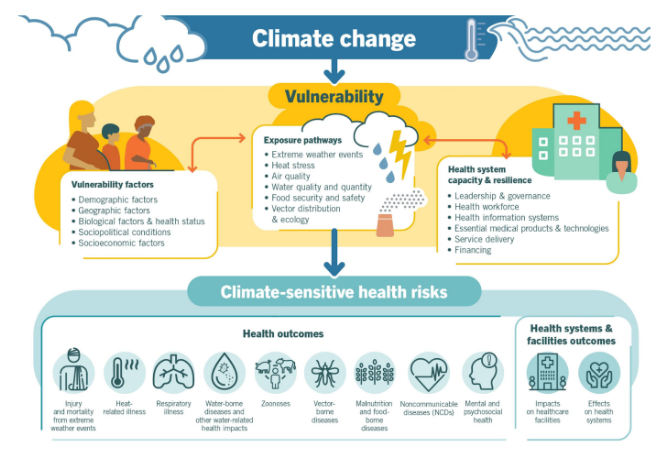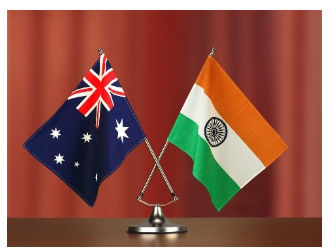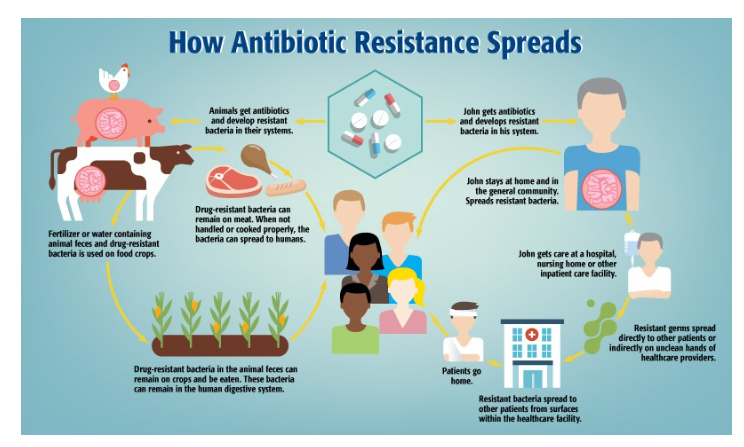Friday, 24th November 2023
Global South Summit's Second Voice
In News: India concluded its second 'Voice of the Global South Summit' (VOGSS) virtually, reaffirming its commitment to fostering solidarity and strengthening its leadership in the Global South.
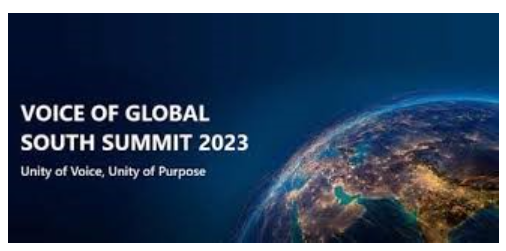
- Themes of Second VOGSS
- Inaugural Session: ‘Together, for Everyone’s Growth, with Everyone’s Trust’
- Concluding Session: ‘Global South: Together for One Future.’
- Objectives of the Summit
- Communicating G20 Summit Outcomes
- Sustaining Momentum for G20 Decisions
- Prioritizing Developing Countries' Interests
- Key Outcomes
- Launch of 'DAKSHIN': Global South Center of Excellence
- Thematic Discussions on SDGs, Energy Transition, Climate Finance, Digital Transformation, Women-Led Development, Counter-Terrorism, and Global Institution Reforms
- India's Stance on Israel-Hamas Conflict
- Expressing Concern for Civilian Plight
- Urging Restraint, Prioritizing Civilian Safety, and Promoting De-escalation
- India's 5 'Cs' for Global South
- Consultation
- Cooperation
- Communication
- Creativity
- Capacity Building
About Global South
- The Global South, often misunderstood as solely a geographical term, encompasses diverse nations facing developmental challenges, shaped by geopolitical, historical, and economic factors.
- It is not strictly confined by location, with countries like India and China in the northern hemisphere.
- The Brandt Line and the G-77 illustrate historical markers of the North-South economic divide.
- In recent times, the Global South has seen a resurgence in influence.
- The COVID-19 pandemic exposed economic imbalances, leading to discussions on repositioning global supply chains.
- The Global South's collective voice has gained prominence in international forums like the G20, altering power dynamics.
- Moreover, their vulnerability to climate change has spurred discussions on climate adaptation and sustainable development, attracting global attention and support.
Indicators of Rising Global South Influence
- ‘Loss and Damage Fund' Establishment at COP27
- The initiation of the 'Loss and Damage Fund' at COP27 in Egypt underscored the disproportionate challenges faced by the Global South.
- Inclusive Approach in Japan's G7 Summit
- Japan's G7 summit demonstrated a laudable effort to incorporate nations like India and Brazil, fostering a more inclusive and diverse dialogue.
- BRICS Expansion to 11 Members
- The expansion of BRICS to 11 members highlighted an enhanced commitment to engagement with the Global South.
- Success of G-77 Summit in Cuba
- The G-77 summit in Cuba effectively united numerous developing nations, addressing pivotal issues collectively.
- African Union's Inclusion in the G20
- The incorporation of the 55-nation African Union into the G20 signifies an increasing acknowledgment of African nations' global significance and their substantial contributions to shaping the global order.
Challenges Faced by India as a Global South Advocate
- Managing Diverse Interests
- Harmonizing diverse political ideologies, economic structures, and geopolitical ambitions in the Global South to present a unified stance on issues like trade, climate change, and security is a significant challenge.
- Addressing Power Asymmetry
- Balancing the influence of emerging powers like India, Brazil, and South Africa with the inclusion of least developed countries requires navigating power dynamics and ensuring fair representation to prevent overshadowing smaller nations.
- Negotiating with Global Powers
- Skillfully advocating for Global South interests amid the dominance of global powers demands strategic negotiation. India must effectively navigate relationships with established powers like the US and the EU, ensuring the Global South's voice is considered in global decision-making.
- Resource Constraints
- Balancing India's developmental needs with its role as a Global South representative is challenging. Limited resources and conflicting domestic priorities within Global South countries often pose hurdles for India.
Forward Path
- Strengthening Regional Alliances
- Enhance collaboration within regional blocs like SAARC, ASEAN, and BIMSTEC to collectively tackle regional challenges, foster economic cooperation, and promote stability.
- Facilitating South-South Cooperation
- Encourage collaboration and knowledge sharing among Global South nations, leveraging strengths in technology, healthcare, education, and sustainable development for mutual benefit.
- Advocating for Equity in Global Governance
- Push for reforms in global governance structures such as the United Nations, IMF, and World Bank, aiming for fair representation and increased decision-making power for the Global South.
- Addressing Climate Change and Sustainability
- Lead by example in adopting sustainable practices, invest in renewable energy, and advocate for global initiatives to combat climate change, considering the developmental needs of Global South nations.
|
UPSC Previous Year Questions Prelims (2020) Q. In which one of the following groups are all the four countries members of G20? (a) Argentina, Mexico, South Africa and Turkey Ans: (a) Mains (2019) Q. ‘The long-sustained image of India as a leader of the oppressed and marginalised nations has disappeared on account of its new found role in the emerging global order.’ Elaborate. |
Source: IE
The Supreme Court calls for an increase in the adoption pool.
In News: In response to a petition filed by an NGO, the Supreme Court of India has directed the Central government, state governments, and union territories to expedite and simplify the adoption process in the country.
Supreme Court Directives on Adoption
- Identification of Eligible Children
- Children in Child Care Institutions (CCIs) with parents who have not visited them in over a year or have unfit guardians should be identified and included in the adoption pool.
- Definition of "Unfit Guardian"
- An "unfit guardian" was defined as someone unable or unwilling for parenting, engaged in substance abuse, alcohol abuse, known for child neglect or abuse, with a criminal record, in need of care themselves, mentally unsound, etc.
- Bi-Monthly Drives
- States and Union Territories were directed to conduct bi-monthly drives to identify children in the orphaned-abandoned-surrendered (OAS) category in CCIs.
- Data Compilation and Sharing
- States and Union Territories were instructed to compile data on potential adoptable children, particularly those in CCIs, and provide details to the Central Adoption Resource Authority (CARA) and the Ministry of Women and Child Development.
- CARINGS Portal Registration
- States were mandated to ensure the registration of all OAS children in the district on the Child Adoption Resource Information and Guidance System (CARINGS) portal, the online platform for adoption in India.
Current Adoption Trends and Statistics in India
- Annual Adoption Figures-CARA reports approximately 4,000 child adoptions annually in India, a notably low number considering there are over 3 Crore orphans as of 2021.
- Mismatch in Adoption Numbers-There is a significant disparity between the number of children available for legal adoption and the count of prospective adoptive parents (PAPs), as indicated by CARA's online portal, CARINGS.
- State-wise Breakdown (October 2023)-As of October 2023, a state-wise analysis by CARA revealed 2,146 children available for adoption, while 30,669 PAPs were registered for in-country adoption.
- Wait Times for PAPs-Prospective adoptive parents often face a waiting period of three to four years to adopt a "healthy and young child" due to the substantial gap between registered PAPs and available children for adoption.
- Age Preferences of PAPs-CARA's data indicates that 69.4% of registered PAPs prefer children aged zero to two years, 10.3% opt for the age group of two to four years, and 14.8% choose children aged four to six years.
- Limited Specialised Adoption Agencies-Out of the 760 districts in India, only 390 have Specialised Adoption Agencies, suggesting a potential geographical constraint in adoption facilitation.
Adoption Challenges in India
- Complex Adoption Process
- The adoption process, governed by various laws, involves intricate steps leading to extended timelines influenced by factors like child availability, parental preferences, administrative efficiency, and legal formalities.
- Child Returns Concerns
- An unusual increase in child returns, particularly affecting girls, those with special needs, and older children, poses challenges due to extended adjustment periods and insufficient preparation for transitioning to new family environments.
- Limited Adoption of Children with Disabilities
- A minimal number of adoptions for children with disabilities highlights a disparity, with only 1% of total adoptions accounting for this group. This trend indicates challenges in addressing the needs of children with special requirements.
- Child Trafficking Issues
- A diminishing pool of adoptable children contributes to illegal adoption activities, raising concerns about child trafficking, particularly affecting vulnerable families during the pandemic.
- Challenges to LGBTQ+ Parenthood
- Legal recognition challenges for LGBTQ+ families hinder adoption, leading to increased illegal adoptions within the queer community, highlighting the need for inclusive adoption policies.
- Societal Stigma and Adoption Awareness
- Social stigma surrounding adoption and limited awareness about the process create barriers for prospective adoptive parents, impacting adoption rates and perpetuating misconceptions.
- Corruption and Litigation Impact
- Instances of corruption and legal disputes within the adoption process compromise its integrity, slowing proceedings and adding complexity to the overall system.
Benefits of Adoption for Children and Society
- Stable Family Environment-Adoption ensures a loving and stable family environment for children deprived of parental care, supporting their holistic development and well-being.
- Holistic Development of Children-Adoption addresses children's physical, mental, emotional, social, and educational needs, contributing to their overall development.
- Social and Economic Development-Adoption reduces the burden on the state and society, empowering adopted children to become productive and responsible citizens, contributing to the country's social and economic development.
- Cultivating a Positive Adoption Culture-Adoption cultivates a positive culture, breaking down social stigmas, and raising awareness about its benefits.
Guidelines for Progress
- Proactive Identification and Inclusion
- Actively identify children in Child Care Institutions (CCIs) with unfit parents or guardians, ensuring their swift inclusion in the adoption pool for an opportunity at securing a permanent family.
- Institutional Preparation and Counseling
- Strengthen institutional efforts to prepare and counsel children, particularly older and disabled individuals, facilitating a smoother transition into new adoptive families.
- Comprehensive Adjustment Programs
- Develop comprehensive programs to address adjustment challenges, ensuring a seamless integration process for adopted children into their new families.
- Public Awareness Campaigns
- Conduct awareness campaigns to educate the public about the advantages of adoption, dispelling stigmas and misconceptions, and fostering a positive perception of adoption.
- International Collaboration against Child Trafficking
- Collaborate with international bodies to combat child trafficking for adoption, reinforcing regulations for inter-country adoption to ensure ethical and legal practices.
Source: TH
COP 28 - Edukemy Current Affairs
In News: As per the findings of IPCC AR6, developed nations have disproportionately claimed a larger portion of the global carbon budget.

About COP (Conference of Parties)
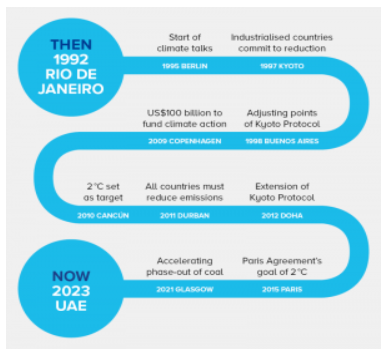
- COP is an acronym for the Conference of Parties.
- Serving as the principal decision-making body of the United Nations Climate Change Framework Convention (UNFCCC), COP holds a pivotal role.
- Convening annually, COP takes place unless mutually decided otherwise by the participating parties.
- Each COP is hosted in a different geographical region, following a rotational schedule among the five United Nations regional groups: The African Group, the Asia-Pacific Group, the Eastern Europe Group, the Latin American and Caribbean Group (GRULAC), and the Western European and Others Group (WEOG).
- The inaugural conference, COP1, took place in Berlin in 1995. Due to the global COVID-19 pandemic, COP26, originally scheduled for 2020, was rescheduled to 2021. Subsequently, COP27 was hosted in Sharm El Sheikh, Egypt.
About COP 28 (UAE)
- The 28th Conference of Parties (COP28) is scheduled to commence in Dubai on November 30, 2023.
- This particular COP holds significant importance as it concludes the inaugural Global Stocktake, a comprehensive assessment evaluating progress toward the objectives of the Paris Agreement.
- The primary aim of the stocktake is to assess global actions against climate change and lay the groundwork for future initiatives.
- The Global Stocktake focuses on three key areas of evaluation:
- Mitigation- Concentrating on efforts to prevent further global warming.
- Adaptation- Addressing strategies to cope with unavoidable impacts of climate change.
- Means of Implementation- Encompassing finance, technology transfer, and capacity building.
COP 28: India’s Significance
- COP 28 is a significant moment for India as it gives the country a key role in global discussions on climate change.
- The conference marks the end of the first-ever Global Stocktake, where progress toward the Paris Agreement goals is assessed.
- India's participation in COP 28 highlights its dedication to addressing climate challenges and contributing to the worldwide effort to combat them.
- Being a major developing nation, India is expected to emphasize fairness and shared responsibilities in climate actions.
- The country may stress the need for financial support and technology transfer to help other developing nations adapt to and mitigate the impacts of climate change.
- Furthermore, India's involvement in COP 28 provides a chance to showcase its initiatives and successes in renewable energy, sustainable development, and other climate-related endeavors.
- In essence, India's role in COP 28 is crucial for shaping global climate policies and reflects its commitment to sustainable and responsible environmental practices on the world stage
Source: TH
PMLA - Edukemy Current Affairs
In News: Recently, a Special Bench led by Justice Sanjay Kishan Kaul in the Supreme Court opted not to proceed with the hearing of petitions challenging amendments to the Prevention of Money Laundering Act (PMLA).
Money Laundering Overview
- Definition
- Money laundering is the process of disguising the origins of large sums of money obtained through criminal activities, such as drug trafficking or terrorist funding, to make it appear as if it comes from a legitimate source.
- Criminal Activities Generating Profits
- Illegal arms sales, smuggling, drug trafficking, prostitution rings, insider trading, bribery, and computer fraud schemes are examples of criminal activities that generate substantial profits, creating an incentive for money launderers to legitimize the illicit gains.
- Dirty Money and Legitimization
- The money generated from criminal activities is termed 'dirty money.' Money laundering involves the transformation of 'dirty money' to make it appear as 'legitimate' money, allowing criminals to use it without raising suspicion.
- Stages of Money Laundering
- Placement
- In the initial stage, crime-generated money is introduced into the formal financial system.
- Layering
- The second stage involves layering, where the injected money undergoes complex transactions to obscure its tainted origin.
- Integration
- Placement
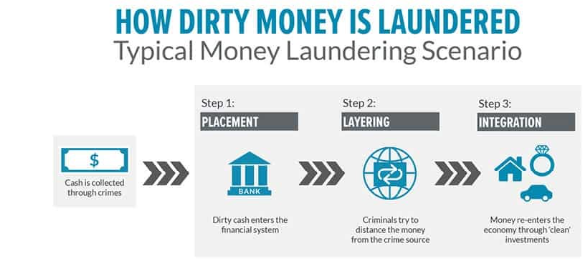
-
-
- The final stage sees the money integrated into the financial system in a way that eliminates its original association with the crime, allowing offenders to use it as 'clean money.
-
Prevention of Money Laundering Act (PMLA), 2002 Overview
Background
- The PMLA was enacted in response to India's commitment under the Vienna Convention to combat money laundering.
- This commitment includes adherence to global initiatives such as the United Nations Convention Against Illicit Traffic in Narcotic Drugs and Psychotropic Substances (1988), Basle Statement of Principles (1989), Forty Recommendations of the Financial Action Task Force on Money Laundering (1990), and the Political Declaration and Global Program of Action adopted by the United Nations General Assembly in 1990.
About
- The PMLA is a criminal law designed to prevent money laundering and facilitate the confiscation of property derived from or involved in money laundering activities.
- It serves as the cornerstone of India's legal framework to combat money laundering.
- The provisions of this act extend to all financial institutions, banks (including RBI), mutual funds, insurance companies, and their financial intermediaries.
Recent Amendments
- Position of Proceeds of Crime Clarification
- The amendment broadens the definition of proceeds of crime, not limited to property derived from scheduled offences but also encompassing any property obtained through criminal activities related or similar to scheduled offences.
- Redefined Money Laundering as Stand-alone Crime
- Previously dependent on another crime (predicate offence or scheduled offence), money laundering is now treated as a stand-alone crime.
- Section 3 of PMLA specifies that a person can be accused of money laundering if directly or indirectly involved in the proceeds of the crime through concealment, possession, acquisition, use, projecting as untainted property, claiming as untainted property.
- Continuing Nature of Offence
- The amendment emphasizes the continuing nature of the offence of money laundering.
- A person is considered involved in this offence until they continue to derive benefits from activities related to money laundering.
Source: TH
CBDR-RC - Edukemy Current Affairs
In News: As per the findings of IPCC AR6, developed nations have disproportionately claimed a larger portion of the global carbon budget
About CBDR-RC Principle
- The principle of Common but Differentiated Responsibilities and Respective Capabilities (CBDR–RC) is a foundational concept embedded in the United Nations Framework Convention on Climate Change (UNFCCC).
- This principle recognizes the distinct capabilities and varying responsibilities that individual countries bear in addressing the complex issue of climate change.
- CBDR–RC is operationalized through the classification of countries into two main groups: "Annex I" and "non-Annex I."
- Generally, Annex I countries consist of developed nations, while non-Annex I countries encompass developing nations.
- This classification aims to acknowledge and accommodate the diverse economic capacities and historical contributions to greenhouse gas emissions among nations.
- Within the framework of the Convention, Annex I countries bear a greater responsibility for mitigation efforts compared to non-Annex I countries.
- This differentiation is rooted in historical considerations, acknowledging that developed countries have historically been the primary contributors to the accumulation of greenhouse gases in the atmosphere.
- The principles of CBDR–RC and the annex classifications were formalized in the 1997 Kyoto Protocol, a crucial international agreement under the UNFCCC.
- The Kyoto Protocol imposed legally binding emissions reduction targets specifically on Annex I countries, recognizing their historical role in the emission of greenhouse gases.
Source: TH
MGNREGA - Edukemy Current Affairs
In News: MGNREGS faces substantial criticism for a high level of corruption, with the Act incorporating a social audit as an inherent mechanism to counteract corruption.
About MGNREGA
- The Mahatma Gandhi National Rural Employment Guarantee Act (MGNREGA) was initiated in 2005 by the Ministry of Rural Development and stands as one of the world's largest work guarantee programs.
- As of 2022-23, it boasts 15.4 crore active workers.
- The core objective of MGNREGA is to provide a guarantee of 100 days of employment per financial year to adult members of any rural household who are willing to engage in unskilled manual work for public projects.
- In a departure from previous employment guarantee schemes, MGNREGA operates within a rights-based framework.
- It legally ensures the right to work, with at least one-third of the beneficiaries being women.
- Wages are mandated to adhere to the statutory minimum wages specified for agricultural laborers in the state under the Minimum Wages Act, 1948.
- A distinctive feature of MGNREGA is its demand-driven nature.
- It guarantees any rural adult the right to work within 15 days of making a demand.
- In cases of failure, an 'unemployment allowance' must be provided.
- This approach enables self-selection of workers.
- MGNREGA places significant emphasis on decentralization, involving Panchayati Raj Institutions (PRIs) in the planning and implementation processes.
- Gram Sabhas are mandated to recommend works to be undertaken, with at least 50% of the works executed by them.
|
UPSC Previous Year Questions Prelims (2011) Q. Among the following who are eligible to benefit from the “Mahatma Gandhi National Rural Employment Guarantee Act”? (a) Adult members of only the scheduled caste and scheduled tribe households Ans: (d) Exp:
|
Source: TH
Project DEFIANT - Edukemy Current Affairs
In News: Vishnu Nandan, has successfully returned after facing the harsh conditions and enduring the polar darkness during his tenure at the Rothera Research Station on Adelaide Island.
About Project DEFIANT
The DEFIANT project is a crucial effort aimed at unraveling the mysteries of sea ice fluctuations in the Antarctic and their profound effects on the Southern Ocean and global climate.
What DEFIANT Aims to Achieve?
- DEFIANT wants to know the secrets behind the ups and downs of Antarctic sea ice.
- Is it the wind, the ocean currents, or how it interacts with the ice shelves? This is the first piece of the puzzle.
- As sea ice dances, it affects the Southern Ocean's heartbeat—the ecosystem. DEFIANT is on a mission to measure how these ice moves and shakes impact everything from tiny phytoplankton to larger marine creatures.
- What happens in the Southern Ocean doesn't stay there. DEFIANT investigates how sea ice changes throw a ripple effect on the global climate—how oceans circulate, soak up heat, and even influence the atmosphere around the world.
- DEFIANT wants to create a big picture, like putting together a giant jigsaw puzzle. By combining insights from different fields—like ice, ocean, and atmosphere studies—the project aims to understand how everything fits in the Southern Ocean.
What DEFIANT Hopes to Uncover?
- By the end of the project, DEFIANT hopes to reveal the secrets behind why Antarctic sea ice acts the way it does. This knowledge could help us predict future changes.
- Understanding how sea ice impacts the Southern Ocean's residents—from tiny critters to majestic marine life—can guide efforts to protect and manage this vital region.
- DEFIANT's discoveries will contribute puzzle pieces to improve climate models. The goal? To enhance our ability to predict and understand climate changes worldwide.
- Lastly, DEFIANT aims to create a special tool—a model—that lets scientists simulate and predict what might happen in the Southern Ocean down the line.
|
UPSC Previous Year Questions Prelims (2021) Q. With reference to the water on the planet Earth, consider the following statements:
Which of the statements given above is/are correct? (a) 1 only Ans: (b) |
Source: TH
Southern Lights (Aurora) - Edukemy Current Affairs
In News: Vishnu Nandan, has successfully returned after facing the harsh conditions and enduring the polar darkness during his tenure at the Rothera Research Station on Adelaide Island.
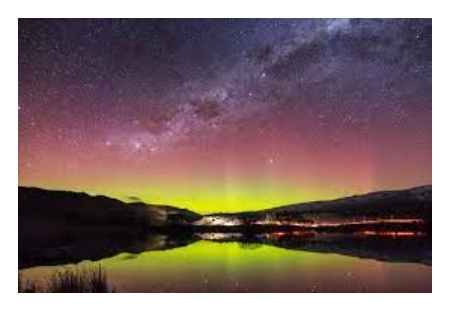
About Aurora
- An Aurora, commonly known as a Polar light, is a captivating display of light predominantly observed in the high latitude regions, such as the Arctic and Antarctic.
- There are two main types of auroras: the aurora borealis, also called the northern lights, and the aurora australis, known as the southern lights.
- These phenomena are less frequent at mid-latitudes and seldom seen near the equator.
- Auroras exhibit a range of colors, typically appearing as milky greenish hues but also displaying red, blue, violet, pink, and white shades.
- These colors manifest in continuously changing shapes, creating a mesmerizing spectacle.
- The scientific explanation for auroras lies in the electric connection between Earth and the Sun.
- Energy from the Sun, coupled with electrically charged particles trapped in Earth's magnetic field, triggers these luminous displays.
- The collisions between fast-moving electrons from space and oxygen and nitrogen in Earth's upper atmosphere result in the emission of photons, producing light.
- Auroras originate at altitudes ranging from 100 to over 400 km.
- The diverse colors and shapes of auroras are influenced by the gases being excited (oxygen or nitrogen), the level of excitement, and the speed of the electrons during collisions.
- High-energy electrons cause oxygen to emit green light, while low-energy electrons produce red light.
- Nitrogen generally contributes to a blue glow, and the blending of these colors can create purples, pinks, and whites.
- Auroras, driven by the Sun's energy in the form of solar wind, can have effects on communication lines, radio signals, and power lines.
- The entire process underscores the intricate interplay between the Sun, Earth's magnetic field, and the gases in our atmosphere, resulting in the breathtaking natural phenomenon of auroras.
|
UPSC Previous Year Questions Prelims Q. If a major solar storm (solar flare) reaches the Earth, which of the following are the possible effects on the Earth?
Select the correct answer using the code given below: (a) 1, 2, 4 and 5 only Ans: (c) |
Source: TH
SEBI - Edukemy Current Affairs
In News: To effectively regulate AI, the implementation of a system with manual overrides, akin to circuit breakers in the financial market, is essential, remarked a member of PMEAC.
About SEBI
- SEBI, established on April 12, 1992, under the Securities and Exchange Board of India Act, 1992, functions as a statutory body with a mandate to safeguard investor interests and regulate the securities market.
- Its inception marked a transition from the Controller of Capital Issues to a more autonomous and empowered regulatory authority.
- Before SEBI's establishment, the regulatory landscape was governed by the Controller of Capital Issues under the Capital Issues (Control) Act, 1947.
- However, recognizing the need for a dedicated regulator, SEBI was constituted in April 1988 as a non-statutory body.
- It gained statutory powers through the SEBI Act, 1992, transforming into an autonomous entity.
- The SEBI Board, led by a Chairman and comprising several whole-time and part-time members, oversees the regulatory framework.
- The headquarters is located in Mumbai, with regional offices in Ahmedabad, Kolkata, Chennai, and Delhi.
- SEBI holds quasi-legislative and quasi-judicial powers, allowing it to draft regulations, conduct inquiries, issue rulings, and impose penalties.
- Its multifaceted functions cater to issuers, investors, and intermediaries.
- For issuers, SEBI provides a marketplace to raise finance, ensuring safety and accurate information for investors.
- Additionally, SEBI regulates venture capital funds, collective investment schemes, and self-regulatory organizations while prohibiting fraudulent practices.
- Recent amendments empower SEBI to regulate money pooling schemes exceeding Rs. 100 crore and conduct "search and seizure" operations under the authority of its Chairman.
- This comprehensive framework positions SEBI as a pivotal player in maintaining market integrity, protecting investors, and fostering a transparent and competitive securities market.
Source: BS
PMEAC (Prime Minister’s Ecnomic Advisory Council)
In News: To effectively regulate AI, the implementation of a system with manual overrides, akin to circuit breakers in the financial market, is essential, remarked a member of PMEAC.
About PMEAC
- PMEAC is a non-constitutional, non-statutory, independent body constituted to provide advice on economic and related issues to the Government of India, specifically to the Prime Minister.
- The council serves to highlight key economic issues to the government of India from a neutral viewpoint.
- It advises the Prime Minister on economic issues like inflation, microfinance, and industrial output.
- For administrative, logistic, planning, and budgeting purposes, the NITI Aayog serves as the Nodal Agency for the PMEAC.
- Terms of Reference of PMEAC:
- Analyzing any issue, economic or otherwise, referred to it by the Prime Minister and advising him thereon,
- Addressing issues of macroeconomic importance and presenting views thereon to the Prime Minister.
- These could be either suo-motu or on reference from the Prime Minister or anyone else.
- It also includes attending to any other task as may be desired by the Prime Minister from time to time.
- Periodic Reports
- Annual Economic Outlook.
- Review of the Economy.
Source: BS
A $5 trillion economy, but who will benefit?
In News: Even as India is poised to become the world's third-largest economy by 2028, 800 million Indians will continue to receive complimentary food grains to combat hunger.
Unveiling Inequities: A Multifaceted Look at Socio-economic Disparities in India
- Gender Injustice
- India's Global Gender Gap ranking (2018) at 142 out of 149 countries.
- Women contend with a substantial gender wage gap, earning 34% less than men.
- Despite constituting 42% of the agricultural workforce, women own less than 2% of farm land.
- Caste Struggles
- Caste plays a pivotal role in determining access to education, income, and health resources.
- Upper caste households earn nearly 47% more than the national average.
- In 2012, the top 10% within upper castes owned 60% of the wealth in the group.
- Faith-Based Inequalities
- Religious identities wield significant influence on an individual's resource access.
- Prejudices stemming from religious identity contribute to economic exclusion.
- While certain minority groups enjoy a larger share of income, Muslim and Buddhist populations face reduced access to economic resources.
- Ethnic Divides
- Ethnic inequalities persist, particularly among tribal communities with unique cultural attributes.
- National Family Health Survey 2015-16 highlights wealth bracket variations among SC, OBC, and ST populations.
- Economic Disparities
- Oxfam's 2019 report underscores substantial wealth concentration, with India's top 10% holding 77.4% of the national wealth.
- The bottom 60% of the population possesses only 4.8% of the national wealth.
- Approximately 13.6 crore Indians in the poorest 10% have remained in debt for the past 15 years.
- India's Gini coefficient, indicating wealth inequality, stood at 0.83 in 2017, placing it among countries with high inequality.
Unraveling the Ripple Effects: Ramifications of Social Inequities in India
- Inequalities in India spawn social conflicts among groups, evident in caste clashes like the demands for reservations by groups such as Jaats, Marathas, and Patels.
- These conflicts highlight the clash of interests, with existing beneficiaries opposing new claims, leading to violent confrontations.
- Ethnic disparities contribute to movements seeking separate states or autonomy, even secession.
- The North East has witnessed ethnic movements, such as the Naga movement for greater Nagalim, underscoring the consequences of ethnic inequalities.
- Religious inequality fosters feelings of exclusion among religious minorities, hindering their mainstream participation.
- In India, this economic exclusion compromises national GDP growth, given the significant population of religious minorities.
- Existing socio-economic inequalities correlate with poor development indicators, including high rates of infant and maternal mortality, low per capita income, subpar education outcomes, and rapid population growth.
- Economic inequality negatively impacts public healthcare and education.
- The upper and middle classes, with access to private alternatives, often lack vested interests in the effectiveness of public healthcare and education systems, exacerbating the consequences of economic disparities.
Building Equality: Strategic Measures to Tackle Socio-Economic Disparities in India
- Constitutional Safeguards
- Enforce constitutional guarantees of equality outlined in fundamental rights, emphasizing Articles 14, 15, and 16.
- These articles collectively form a crucial framework ensuring the right to equality.
- Civil Society Empowerment
- Empower traditionally oppressed groups by amplifying their voices through civil society entities such as unions and associations.
- Encourage entrepreneurship among Scheduled Castes and Scheduled Tribes, expanding initiatives like Stand Up India to enhance accessibility through increased funding.
- Women's Empowerment
- Promote gender equality through affirmative action, reserving seats in legislatures, ensuring 50% reservation at local self-government levels, enforcing The Equal Remuneration Act, 1976 to bridge the wage gap, introducing gender-sensitive education curricula, raising awareness with programs like Beti Bachao Beti Padhao.
- Inclusion of Religious Minorities
- Address the needs of religious minority groups with a focus on representation in government jobs, provision of institutional credit, improved education access, protection of human rights through an empowered National Commission for Minorities, and reinforcing the rule of law.
- Progressive Taxation
- Generate additional public resources for essential services by implementing progressive taxes on the wealthy and enhancing corporate taxation, with a crucial emphasis on broadening the tax base through improved financial transaction monitoring.
- Economic Policy Reforms
- Ensure universal access to high-quality public services, including healthcare, education, and social security benefits. Implement employment guarantee schemes to significantly reduce inequality.
- Employment Generation
- Prioritize the growth of labor-intensive manufacturing sectors such as textiles, clothing, automobiles, and consumer goods.
- This strategy aims to absorb millions leaving farming, addressing the rural-urban migration challenge and benefiting the broader population.
Source: TH
Share the article
Edukemy’s Current Affairs Quiz is published with multiple choice questions for UPSC exams
MCQ
Get Latest Updates on Offers, Event dates, and free Mentorship sessions.

Get in touch with our Expert Academic Counsellors 👋
FAQs
UPSC Daily Current Affairs focuses on learning current events on a daily basis. An aspirant needs to study regular and updated information about current events, news, and relevant topics that are important for UPSC aspirants. It covers national and international affairs, government policies, socio-economic issues, science and technology advancements, and more.
UPSC Daily Current Affairs provides aspirants with a concise and comprehensive overview of the latest happenings and developments across various fields. It helps aspirants stay updated with current affairs and provides them with valuable insights and analysis, which are essential for answering questions in the UPSC examinations. It enhances their knowledge, analytical skills, and ability to connect current affairs with the UPSC syllabus.
UPSC Daily Current Affairs covers a wide range of topics, including politics, economics, science and technology, environment, social issues, governance, international relations, and more. It offers news summaries, in-depth analyses, editorials, opinion pieces, and relevant study materials. It also provides practice questions and quizzes to help aspirants test their understanding of current affairs.
Edukemy's UPSC Daily Current Affairs can be accessed through:
- UPSC Daily Current Affairs can be accessed through Current Affairs tab at the top of the Main Page of Edukemy.
- Edukemy Mobile app: The Daily Current Affairs can also be access through Edukemy Mobile App.
- Social media: Follow Edukemy’s official social media accounts or pages that provide UPSC Daily Current Affairs updates, including Facebook, Twitter, or Telegram channels.


